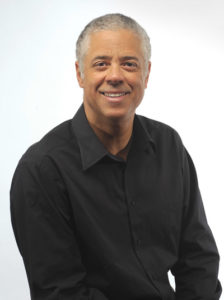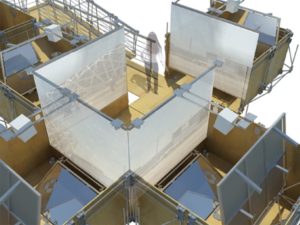A TEACHER'S VIEW
Thomas Fowler IV, AIA, NCARB, DPACSA
Professor and Director
Community Interdisciplinary Design Studio (CIDS)
College of Architecture and Environmental Design
California Polytechnic State University
San Luis Obispo, California

Why and how did you become an architect?
My primary motivation for pursuing architecture began with an interest at a very young age and a desire to understand how everything worked by taking things apart and sometimes getting them back together (not always). I did not know of another profession at the time that would give me a global sense of how things worked and how to document discoveries of what I found through drawings and model making. I had very naïve but romantic notions of what architects supposedly did—but this was just the vehicle that propelled me into going to school to learn about more about architecture.
Why and how did you decide on which school to attend for your architecture degree? What degree(s) do you possess?
I possess a Bachelor of Architecture from New York Institute of Technology/Old Westbury and a Master of Architecture from Cornell University. My decision for selecting my undergraduate institution was based on what I could afford to pay, the location, and which schools would admit me. Selecting the graduate program was because of an opportunity to work as an administrator and do graduate work at the same time. The reason for pursuing graduate work was to obtain additional design theory and to explore the possibilities of teaching.
What is the greatest challenge facing the future of the profession?
The greatest challenge is the lack of accessible and visible role models in the profession and in the academic environments for aspiring ethnic minority and women students interested in pursuing this field.
From my own experience, I was fortunate to have a cousin that practiced architecture in New York City who allowed me to work in his office from high school through my undergraduate studies. This was the component of my education that actually kept me in school, since my challenge was to see the relevancy of my schooling to the eventual practice of architecture. For all students, some linkage to role models is helpful when things do get tough to sort out while in school.
From my undergraduate education and beyond, I have always been very fortunate to find role models to keep me on track and to expose me to opportunities that I would not had known about otherwise. I think it is important to have a strong sense of your destination but have some flexibility as to what the path might be to achieve this goal. Ultimately, stay agile in your ability to modify your future goals as they relate to experiences acquired on your path of learning.
How does your work as a faculty member inform your architectural practice and vice versa?
Being constantly surrounded by the same age group of bright minds, always made up of a diverse range of individuals, who are able to generate a collective range of other ways of seeing a problem is a valuable learning experience to the teacher. Teachers learn at an accelerated rate from their students. Students will always challenge the conventions on how things go to together.
As an academic whose practice of architecture is embedded in working with students in the design and construction of a range of full scaled building mockups, prototypical structures, temporary structures and a range of community design projects has developed a form of practice that has been helpful in acquiring examples to show students regarding the intimate process of how design and the construction process works at a smaller scale. The academic involved in practice always has a voice in the back of his/her mind asking the question “how can I capture this process in such a way as to explain it to students so they will be able to learn from it.”

Lumeire Ghosting Portable Theater Project, CIDS Project at California Polytechnic State University–San Luis Obispo, CA
What are your primary responsibilities and duties as an architect and as a faculty member?
I think some practitioners want to see faculty as practicing architects first and as academicians second—since it seems to be a logical way to ensure that students will be learning the skills that they need to become architects. From my experience being a practitioner first does not ensure this linkage to practice, but this depends more on what teaching strategies that are developed to provide students with the tools for understanding these connections.
Practitioners need to understand that they play an important role in the education of architects too. There is also talk about needing students to deal with more of a complexity of design issues while in school, but I would argue issues have to be simplified so students can develop ideas beyond the planning stages of a project into constructible architectural vocabularies. Acceptable levels of design development are lacking in many studios since too much time is spent on thinking about the complexities.
How does teaching differ from practicing architecture?
What a teacher does is very much a mystery to those who do not teach, which I think is more of a problem for universities to solve regarding how to decode the process for what academics do as opposed to non-academics. I often hear that the role of an architecture professor is to teach students the skills to build buildings. I would argue the role of an architecture professor is far greater than just this. Teaching is more of a modeling of future citizens who will make great contributions to society as upstanding citizens in addition to also having the knowledge to create architecture. Good teaching is where both the student and teacher learn from the interaction. This is why most are attracted to teaching—since this role provides a continuous mechanism to learn.
...Good teaching is where both the student and teacher learn from the interaction.
During your career, you have been a member of more than one of the national boards of the collateral organizations. What has that involvement meant for your career?
It is often the perception that individuals who become involved as volunteers with associations have limited interest in the broader issues that affect the profession (i.e., design, etc.). I have the opposite view that active involvement with the collateral organizations has given me a broader view and appreciation for the profession. Navigating association work is the ultimate design problem for consensus building as you move through this kind of bureaucracy.
I served as national president of the AIAS (1984–1985) and served as Association of Collegiate Schools of Architecture (ACSA) faculty advisor (2001–2003), served as secretary for the ACSA (2004–2006), and board member for National Architectural Accrediting Board (NAAB) (2006–2008) and secretary (2007–2008). Involvement in association work allows you to establish a macro view of the profession through a variety of networks that over time disperse and expand as people move on to different things.
